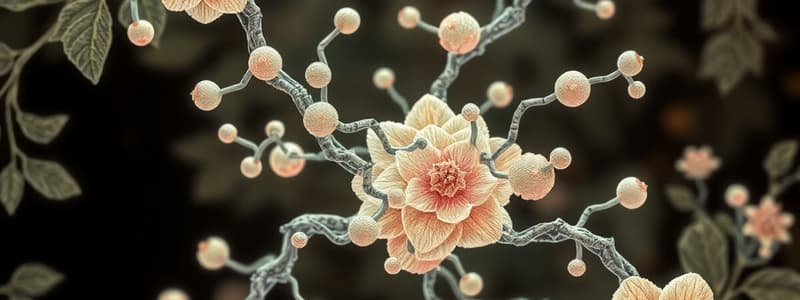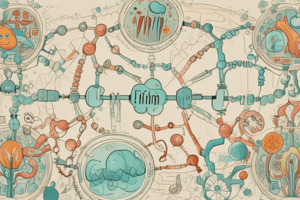Podcast
Questions and Answers
What substance is formed when homogentisic acid oxidizes and polymerizes?
What substance is formed when homogentisic acid oxidizes and polymerizes?
- Melanin
- Tyrosinase
- Urocanic acid
- Alkapton (correct)
What is a characteristic symptom of alkaptonuria?
What is a characteristic symptom of alkaptonuria?
- Brown spots on skin
- Deficiency of melanin
- Urine resembling coke in color (correct)
- Excessive sun sensitivity
What diagnostic test results in a green color when testing for homogentisic acid?
What diagnostic test results in a green color when testing for homogentisic acid?
- Urine culture test
- Benedict's test
- Ferric chloride test (correct)
- Histidine load test
Which enzyme deficiency leads to albinism?
Which enzyme deficiency leads to albinism?
What does excessive excretion of FIGlu in urine indicate?
What does excessive excretion of FIGlu in urine indicate?
What is the first irreversible step in histidine catabolism?
What is the first irreversible step in histidine catabolism?
What are the three common steps in the catabolism of branched chain amino acids?
What are the three common steps in the catabolism of branched chain amino acids?
Where is the primary site for the catabolism of branched chain amino acids?
Where is the primary site for the catabolism of branched chain amino acids?
Which amino acids are primarily involved in branched chain amino acid catabolism?
Which amino acids are primarily involved in branched chain amino acid catabolism?
What role do coenzymes play in the catabolism of branched chain amino acids?
What role do coenzymes play in the catabolism of branched chain amino acids?
How is the α-keto acid dehydrogenase complex regulated?
How is the α-keto acid dehydrogenase complex regulated?
What is Maple Syrup Urine Disease associated with?
What is Maple Syrup Urine Disease associated with?
What physical characteristics are associated with individuals suffering from Maple Syrup Urine Disease?
What physical characteristics are associated with individuals suffering from Maple Syrup Urine Disease?
What impact does the accumulation of branched chain amino acids have on the body?
What impact does the accumulation of branched chain amino acids have on the body?
What can happen to the mental development of infants with Maple Syrup Urine Disease?
What can happen to the mental development of infants with Maple Syrup Urine Disease?
What is the primary characteristic of phenylketonuria?
What is the primary characteristic of phenylketonuria?
What specific odor is associated with the urine of individuals affected by phenylketonuria?
What specific odor is associated with the urine of individuals affected by phenylketonuria?
Which of the following is a notable symptom of phenylketonuria?
Which of the following is a notable symptom of phenylketonuria?
What dietary change is crucial for managing phenylketonuria?
What dietary change is crucial for managing phenylketonuria?
What is now considered an essential amino acid for individuals with phenylketonuria in early years?
What is now considered an essential amino acid for individuals with phenylketonuria in early years?
Which test is used to diagnose phenylketonuria by detecting phenylalanine levels in blood?
Which test is used to diagnose phenylketonuria by detecting phenylalanine levels in blood?
What byproduct is tested for in the urine during the diagnosis of phenylketonuria?
What byproduct is tested for in the urine during the diagnosis of phenylketonuria?
What is one of the metabolic fates of tyrosine?
What is one of the metabolic fates of tyrosine?
Where does the catabolism of tyrosine primarily occur?
Where does the catabolism of tyrosine primarily occur?
What condition is characterized by the accumulation and excretion of tyrosine and its metabolites?
What condition is characterized by the accumulation and excretion of tyrosine and its metabolites?
What is the primary characteristic of intermittent branched chain ketonuria?
What is the primary characteristic of intermittent branched chain ketonuria?
What is the primary method for diagnosing isovalERIC acidaemia?
What is the primary method for diagnosing isovalERIC acidaemia?
Which amino acid is primarily affected in isovalERIC acidaemia?
Which amino acid is primarily affected in isovalERIC acidaemia?
What is the cofactor required for the hydroxylation of phenylalanine to tyrosine?
What is the cofactor required for the hydroxylation of phenylalanine to tyrosine?
What symptoms are associated with isovalERIC acidaemia when subjects are fed protein?
What symptoms are associated with isovalERIC acidaemia when subjects are fed protein?
What condition can result from deficiency in phenylalanine hydroxylase or related cofactors?
What condition can result from deficiency in phenylalanine hydroxylase or related cofactors?
In the catabolism of phenylalanine, what compound is formed after its hydroxylation?
In the catabolism of phenylalanine, what compound is formed after its hydroxylation?
What condition is associated with the deficiency of fumarylacetoacetase?
What condition is associated with the deficiency of fumarylacetoacetase?
How is intermittent branched chain ketonuria best managed?
How is intermittent branched chain ketonuria best managed?
Which of the following symptoms is NOT associated with the acute form of Type I Tyrosinaemia?
Which of the following symptoms is NOT associated with the acute form of Type I Tyrosinaemia?
What odor is typically associated with isovalERIC acidaemia?
What odor is typically associated with isovalERIC acidaemia?
What metabolic issue is primarily noted in Type II Tyrosinaemia?
What metabolic issue is primarily noted in Type II Tyrosinaemia?
What deficiency leads to accumulation and excretion of isovalerate in urine?
What deficiency leads to accumulation and excretion of isovalerate in urine?
What is a common symptom found in both acute Type I Tyrosinaemia and Type II Tyrosinaemia?
What is a common symptom found in both acute Type I Tyrosinaemia and Type II Tyrosinaemia?
Which of the following is a characteristic feature of Type III Tyrosinaemia?
Which of the following is a characteristic feature of Type III Tyrosinaemia?
In which condition do affected subjects excrete large amounts of homogentisic acid in their urine?
In which condition do affected subjects excrete large amounts of homogentisic acid in their urine?
Which type of Tyrosinaemia is also referred to as hepato-renal tyrosinaemia?
Which type of Tyrosinaemia is also referred to as hepato-renal tyrosinaemia?
What is the main cause of the symptoms associated with Type I Tyrosinaemia?
What is the main cause of the symptoms associated with Type I Tyrosinaemia?
What percentage of neonates may experience temporarily elevated levels of tyrosine?
What percentage of neonates may experience temporarily elevated levels of tyrosine?
Flashcards
Catabolism of Branched-Chain Amino Acids
Catabolism of Branched-Chain Amino Acids
The breakdown of leucine, isoleucine, and valine into energy or other molecules.
Transamination
Transamination
The transfer of an amino group from one molecule to another, forming an α-keto acid.
Oxidative Decarboxylation (BCKD)
Oxidative Decarboxylation (BCKD)
Conversion of α-keto acids to acyl-CoA molecules in mitochondria.
Acyl-CoA Dehydrogenase
Acyl-CoA Dehydrogenase
Signup and view all the flashcards
Branched-Chain α-Keto Acid Dehydrogenase Complex (BCKDC)
Branched-Chain α-Keto Acid Dehydrogenase Complex (BCKDC)
Signup and view all the flashcards
Maple Syrup Urine Disease (MSUD)
Maple Syrup Urine Disease (MSUD)
Signup and view all the flashcards
α-keto acids
α-keto acids
Signup and view all the flashcards
Covalent Modification
Covalent Modification
Signup and view all the flashcards
Primary site of BCAA catabolism
Primary site of BCAA catabolism
Signup and view all the flashcards
Intermittent Branched-Chain Ketonuria
Intermittent Branched-Chain Ketonuria
Signup and view all the flashcards
Branched-chain amino acids
Branched-chain amino acids
Signup and view all the flashcards
Isovaleric acidemia
Isovaleric acidemia
Signup and view all the flashcards
Isovalerate
Isovalerate
Signup and view all the flashcards
Leucine
Leucine
Signup and view all the flashcards
Phenylalanine Hydroxylase
Phenylalanine Hydroxylase
Signup and view all the flashcards
Phenylketonuria (PKU)
Phenylketonuria (PKU)
Signup and view all the flashcards
Tetrahydrobiopterin
Tetrahydrobiopterin
Signup and view all the flashcards
Catabolism of Phenylalanine
Catabolism of Phenylalanine
Signup and view all the flashcards
Dihydrobiopterin Reductase
Dihydrobiopterin Reductase
Signup and view all the flashcards
Phenylketonuria (PKU)
Phenylketonuria (PKU)
Signup and view all the flashcards
PKU Symptoms
PKU Symptoms
Signup and view all the flashcards
PKU Urine Odor
PKU Urine Odor
Signup and view all the flashcards
PKU Diet Management
PKU Diet Management
Signup and view all the flashcards
PKU Diagnosis - Guthrie Test
PKU Diagnosis - Guthrie Test
Signup and view all the flashcards
PKU Diagnosis - Ferric Chloride Test
PKU Diagnosis - Ferric Chloride Test
Signup and view all the flashcards
Tyrosine Metabolism
Tyrosine Metabolism
Signup and view all the flashcards
Tyrosine Catabolism
Tyrosine Catabolism
Signup and view all the flashcards
Tyrosinemia
Tyrosinemia
Signup and view all the flashcards
Tetrahydrobiopterin
Tetrahydrobiopterin
Signup and view all the flashcards
Homogentisic Aciduria
Homogentisic Aciduria
Signup and view all the flashcards
Albinism
Albinism
Signup and view all the flashcards
Histidine Catabolism
Histidine Catabolism
Signup and view all the flashcards
FIGLU (Formiminoglutamate)
FIGLU (Formiminoglutamate)
Signup and view all the flashcards
Folate Deficiency
Folate Deficiency
Signup and view all the flashcards
Melanin Synthesis
Melanin Synthesis
Signup and view all the flashcards
Tyrosinaemia
Tyrosinaemia
Signup and view all the flashcards
Type I Tyrosinaemia
Type I Tyrosinaemia
Signup and view all the flashcards
Acute Type I Tyrosinaemia
Acute Type I Tyrosinaemia
Signup and view all the flashcards
Chronic Type I Tyrosinaemia
Chronic Type I Tyrosinaemia
Signup and view all the flashcards
Type II Tyrosinaemia
Type II Tyrosinaemia
Signup and view all the flashcards
Type III Tyrosinaemia
Type III Tyrosinaemia
Signup and view all the flashcards
Homogentisate-1,2-dioxygenase Deficiency
Homogentisate-1,2-dioxygenase Deficiency
Signup and view all the flashcards
Tyrosine Elevation in Neonates
Tyrosine Elevation in Neonates
Signup and view all the flashcards
Vit C Deficiency
Vit C Deficiency
Signup and view all the flashcards
Fumaryl Acetoacetate
Fumaryl Acetoacetate
Signup and view all the flashcards
Study Notes
Fate of the Carbon Skeleton of Amino Acids
- Amino acid carbon skeletons are broken down to produce energy or used to synthesize other molecules.
- Different amino acids have different fates.
- For branched-chain amino acids (BCAAs), their catabolism primarily occurs in skeletal muscle.
Catabolism of Branched-Chain Amino Acids
- The process begins with transamination, converting BCAAs into α-keto acids.
- Oxidative decarboxylation, a critical step, occurs, involving a complex, and is then reduced into Acyl CoA thioester.
- Finally, a series of dehydrogenation reactions convert the Acyl CoA.
Leucine, Isoleucine & Valine
- The primary site for catabolism of these branched-chain amino acids is skeletal muscle.
- A specific aminotransferase begins the process within the cytosol.
- This enzyme converts the amino acids to α-keto acids using α-ketoglutarate as an acceptor.
- This reaction is called a transamination reaction.
- Subsequent steps, involving a dehydrogenase complex, occur within the mitochondria.
Catabolism of Leucine, Isoleucine & Valine
- The α-keto acids undergo oxidative decarboxylation using a branched-chain α-keto acid dehydrogenase complex.
- This multi-enzyme complex uses five coenzymes: Thiamine pyrophosphate (TPP), CoASH, Lipoamide, FAD, and NAD+.
- The process converts the α-keto acids to the corresponding acyl CoA thioesters.
Regulation of Catabolism
- The branched-chain α-keto acid dehydrogenase complex activity is regulated through covalent modification.
- Phosphorylation inactivates the complex.
- Dephosphorylation activates the complex.
- This regulation responds to dietary branched-chain amino acids.
Maple Syrup Urine Disease (MSUD)
- A deficiency in the branched-chain α-keto acid dehydrogenase complex causes MSUD.
- It's marked by the build-up of branched-chain α-keto acids in the blood, excreted in the urine.
- Urine and sweat have a distinctive maple syrup or burnt sugar odor.
- MSUD can lead to mental retardation and death if left untreated.
- Dietary restriction of branched-chain amino acids is a crucial management strategy.
- Some patients respond to thiamine supplementations.
Intermittent Branched-Chain Ketonuria (IBCK)
- A less severe form of MSUD, characterized by less severe deficiency in the branched-chain α-keto acid dehydrogenase complex.
- Symptoms typically appear later in life and are intermittent.
- Dietary restriction of branched-chain amino acids is more effective than in other MSUD forms.
Isovaleric Acidemia
- Deficiency in isovaleryl CoA dehydrogenase, an enzyme required for leucine catabolism.
- Leads to the accumulation and excretion of isovalerate (isovaleric acid).
- Urine and breath of affected individuals exhibit a "cheesy" odor.
- Affected individuals may experience vomiting, acidosis, and coma (especially during protein intake).
- Managed by restricting dietary leucine intake.
Catabolism of Phenylalanine
- Phenylalanine is usually hydroxylated to tyrosine by phenylalanine hydroxylase in the liver.
- The reaction requires tetrahydrobiopterin (BH4) as a cofactor.
Phenylketonuria (PKU)
- Results from a deficiency in phenylalanine hydroxylase or the enzyme that regenerates BH4.
- Leads to the accumulation of phenylalanine and phenylketones in the blood.
- This results in excretion in the urine.
- The condition, if left untreated, potentially leads to mental retardation.
- Patients should strictly limit dietary phenylalanine intake, alongside introducing tyrosine to the diet.
Catabolism of Tyrosine
- Tyrosine breakdown through a series of reactions leads to the production of fumarate and acetoacetate.
- The process includes transamination, dioxygenation, isomerization, and hydrolysis reactions.
- Liver is the main site of tyrosine catabolism.
Tyrosinaemia
- Characterized by the buildup and excretion of tyrosine and its metabolic products in the body.
- This can arise from different deficiencies which vary in severity.
- In some cases, it is temporary due to vitamin C deficiency or immature liver enzyme function; in other cases, it is more severe and becomes chronic.
Type I Tyrosinaemia
- Caused by a deficiency in fumarylacetoacetate hydrolase.
- Fumaryl-acetoacetate and fumaryl-acetoacetate accumulate, causing liver and kidney damage.
- Can present in acute and chronic forms, with unique symptoms.
Type II Tyrosinaemia
- Deficiency in tyrosine aminotransferase leads to accumulation and excretion of tyrosine.
- Associated with eye and skin abnormalities and, less frequently, with mental retardation.
Type III Tyrosinaemia
- Characterized by a deficiency in para-hydroxyphenylpyruvate dioxygenase.
- The condition displays diverse characteristics in terms of symptoms.
Homogentisic Aciduria (Alkaptonuria)
- A deficiency in homogentisate 1,2-dioxygenase leads to homogentisic acid accumulation and excretion in the urine.
- The urine darkens on exposure to air due to the formation of alkapton.
- Can lead to ochronosis (discoloration of connective tissue) and arthritis in later life.
Melanin Synthesis
- Melanin, the pigment in skin, hair, and eyes, is synthesized within melanosomes within melanocytes.
- The process starts with L-tyrosine, followed by the action of tyrosinase.
Albinism
- A genetic disorder where the enzyme tyrosinase is deficient, leading to reduced or absent melanin production in skin, hair, and eyes.
- Affected individuals are highly susceptible to sunlight and skin cancer.
Catabolism of Histidine
- Histidine catabolism begins with the irreversible conversion of histidine to urocanic acid, catalyzed by histidine ammonia lyase.
- Urocanic acid is later converted to formiminoglutamate (FIGLU).
- FIGLU is converted further, requiring folate or vitamin B12.
Histidinaemia
- A condition resulting from a deficiency in histidine ammonia lyase (HAA).
- Characterized by elevated blood and urine levels of histidine.
- Some cases are accompanied by speech impairment and/or mental retardation.
Studying That Suits You
Use AI to generate personalized quizzes and flashcards to suit your learning preferences.




